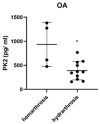Prokineticin 2 and Cytokine Content in the Synovial Fluid of Knee Osteoarthritis and Traumatic Meniscal Tear Patients: Preliminary Results
- PMID: 37445367
- PMCID: PMC10342294
- DOI: 10.3390/jcm12134330
Prokineticin 2 and Cytokine Content in the Synovial Fluid of Knee Osteoarthritis and Traumatic Meniscal Tear Patients: Preliminary Results
Abstract
Knee osteoarthritis (OA) is a chronic degenerative inflammatory-based condition caused by a cascade of different intra-articular molecules including several cytokines. Among the cytokines, prokineticins (PKs) have recently been identified as important mediators of inflammation and pain. This observational study examined the potential involvement of PK2 in degenerative or traumatic knee disease. Fifteen patients presenting knee osteoarthritis (OA group) and 15 patients presenting a traumatic meniscal tear (TM group) were studied. Synovial fluid samples from affected knees were assessed for PK2, IL-10, and TNF-α using the ELISA method. At a long-term follow-up (minimum 5 years, mean = 6.1 years), patients in the TM group underwent clinical re-evaluation with PROMs (Tegner Activity Scale, IKDC, Lysholm, SKV); in addition, X-ray visualization was used to assess the presence of secondary OA. PK2 was detected in synovial fluids of both TM and OA patients and the levels were comparable between the two groups, while IL-10 levels were significantly greater in the OA group than those in TM patients. PK2 levels correlated with those of IL-10. PK2 levels were greater in blood effusions compared to clear samples, did not differ significantly between sexes, nor were they related to differences in weight, height, or injury (meniscal laterality, time since dosing). No correlation was found between PROMs and radiological classifications in patients in the TM group at final follow-up. These data are the first observations of PK2 in synovial fluid following traumatic meniscus injury. These findings suggest possible further prognostic indices and therapeutic targets to limit the development of secondary OA.
Keywords: cytokines; knee; meniscus; osteoarthritis; prokineticins; synovial.
Conflict of interest statement
The authors declare no conflict of interest.
Figures








Similar articles
-
Comparison of Synovial Fluid Cytokine Levels between Traumatic Knee Injury and End-Stage Osteoarthritis.J Knee Surg. 2017 Feb;30(2):128-133. doi: 10.1055/s-0036-1583269. Epub 2016 Apr 28. J Knee Surg. 2017. PMID: 27123668
-
Differential inflammation-mediated function of prokineticin 2 in the synovial fibroblasts of patients with rheumatoid arthritis compared with osteoarthritis.Sci Rep. 2021 Sep 15;11(1):18399. doi: 10.1038/s41598-021-97809-z. Sci Rep. 2021. PMID: 34526577 Free PMC article.
-
Long-term follow-up of bucket-handle meniscal repairs: chondroprotective effect outweighs high failure risk.Knee Surg Sports Traumatol Arthrosc. 2022 Jul;30(7):2209-2214. doi: 10.1007/s00167-021-06787-2. Epub 2021 Nov 6. Knee Surg Sports Traumatol Arthrosc. 2022. PMID: 34741626
-
Clinical Outcomes and Osteoarthritis at Very Long-term Follow-up After ACL Reconstruction: A Systematic Review and Meta-analysis.Orthop J Sports Med. 2022 Jan 7;10(1):23259671211062238. doi: 10.1177/23259671211062238. eCollection 2022 Jan. Orthop J Sports Med. 2022. PMID: 35024368 Free PMC article. Review.
-
Single-stage repair of displaced bucket-handle meniscal tears with anterior cruciate ligament reconstruction leads to good meniscal survivorship : a retrospective cohort study.Bone Joint J. 2022 Jun;104-B(6):680-686. doi: 10.1302/0301-620X.104B6.BJJ-2021-1340.R2. Bone Joint J. 2022. PMID: 35638209 Review.
Cited by
-
Aberrant highly prokineticin 2 and its association with inflammatory indexes and functional recovery in acute ischemic stroke patients.Front Neurol. 2025 Jul 10;16:1559688. doi: 10.3389/fneur.2025.1559688. eCollection 2025. Front Neurol. 2025. PMID: 40708957 Free PMC article.
-
An increase in paediatric arthroscopy in Europe: Experience of the EPOS Sport Study Group.J Child Orthop. 2024 Nov 28;19(1):64-74. doi: 10.1177/18632521241302997. eCollection 2025 Feb. J Child Orthop. 2024. PMID: 39619109 Free PMC article.
-
Prokineticin System Is a Pharmacological Target to Counteract Pain and Its Comorbid Mood Alterations in an Osteoarthritis Murine Model.Cells. 2023 Sep 12;12(18):2255. doi: 10.3390/cells12182255. Cells. 2023. PMID: 37759478 Free PMC article.
-
Synovial fluid as a complex molecular pool contributing to knee osteoarthritis.Nat Rev Rheumatol. 2025 Aug;21(8):447-464. doi: 10.1038/s41584-025-01271-4. Epub 2025 Jul 7. Nat Rev Rheumatol. 2025. PMID: 40624394 Review.
References
-
- Bigoni M., Zanchi N., Turati M. Healing potential and surgical treatment of anterior cruciate ligament rupture in pediatric population. Sport Sci. Health. 2017;13:645–646. doi: 10.1007/s11332-017-0375-4. - DOI
LinkOut - more resources
Full Text Sources
Miscellaneous

